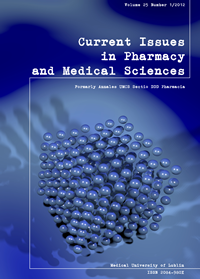Lipophilicity study of ursodeoxycholic acid
DOI:
https://doi.org/10.12923/j.2084-980X/25.1/a.06Słowa kluczowe:
lipophilicity, ursodeoxycholic acid, RP-TLC, RP-HPTLC, bile acids, cluster analysisAbstrakt
In this work, the researchers determined the chromatographic parameter of the lipophilicity (RMW) of ursodeoxycholic acid under various chromatographic conditions, and using the RP-TLC and RP-HPTLC methods. This chromatographic analysis was performed on different glass and aluminum plates (RP-18F254, RP-18WF254 and on RP-2F254), with the use of a mixture of various organic modifiers (methanol, acetone or dioxane) and water, in respective volume compositions. The results of these chromatographic investigations (RMW values) were compared with the partition coefficient (logP) obtained by way of the use of several theoretical methods (expressed as: AlogPs, logPKOWWIN, xlogP2, xlogP3, milogP, AlogP, and MlogP) and with the experimental logP (logPexp), respectively. The similarity between the chromatographically determined and computational calculated parameters of lipophilicity shows the possibility of applying both the chromatographic and theoretical methods to predict the lipophilicity value of ursodeoxycholic acid. The further direction of this study will be towards the application of the obtained lipophilicity parameters of examined bile acid in SAR studies (structure-activity relationships).
Bibliografia
1. Aleksic M. et al.: Estimation of the hydrophobicity of antimycotic compounds by planar chromatography. J. Planar Chromatogr., 15 (6), 414, 2002.
2. Boryczka S., Kulig K. and Malawska B. et al.: RP-TLC determination of the lipophilicity of anticancer–active propargyl thioquinolines. J. Planar Chromatogr., 16 (2), 117, 2003.
3. Dołowy M.: Comparative study of the lipophilicity of selected tauro-conjugates bile acids determined with use of RPTLC and RPHPTLC methods.
J. Liq. Chromatogr. & Rel. Technol., 32 (15), 2281, 2009.
4. Dołowy M.: Wyznaczenie lipofilowości acidum dehydrocholicum różnymi metodami. Farm. Pol. 65 (10), 689, 2009.
5. Jóźwiak K., Szumiło H. and Soczewiński E.: Lipophilicity, methods of determination and its biological effect of chemical substances. Wiad. Chem., 55 (11-12), 1047, 2001.
6. http://www.vcclab.org/lab/alogps/start.html. Virtual Computational Chemistry Laboratory, 2011.
7. Kępczyńska E. et al.: Lipophilicity of thiobarbiturates determined by TLC. Acta Pol. Pharm.–Drug Res. 64 (4), 295, 2007.
8. Kulig K. and Malawska B.: RP-TLC determination of the lipophilicity of 1- substituted pyrrolidin-2-one derivatives. Correlation of the lipophilicity with affinity for -adrenoceptors. J. Planar Chromatogr., 22 (2), 141, 2009.
9. Malawska B.: Determination of the lipophilicity of some N-substituted amides of -piperazine--hydroxybutyric. J. Planar Chromatogr., 11 (2), 137, 1998.
10. Matysik G.: Problemy optymalizacji chromatografii cienkowarstwowej. Wyd. Ay6kademii Medycznej, Lublin 1997.
11. Medic–Saric M., Mornar A.and Jasprica I.: Lipophilicity study of salicylamide. Acta Pharm. 54, 91, 2004
12. Pharmindex, Warsaw: CMP Medica 2011.
13. Pyka A. and Dołowy M.: Lipophilicity of selected bile acids as determined by TLC. J. Liq. Chromatogr. & Rel. Technol., 26 (16), 2741, 2003.
14. Pyka A., Dołowy M.: Lipophilicity of selected bile acids as determined by TLC. II. Investigations on RP18W stationary phase. J. Liq. Chromatogr. & Rel. Technol., 28 (2), 297, 2005.
15. Pyka A., Dołowy M. and Gurak D.: Lipophilicity of selected bile acids as determined by TLC. IV. Investigations on CNF254 stationary phase. J. Liq. Chromatogr. & Rel. Technol., 28 (17), 2705, 2005.
Pobrania
Opublikowane
Numer
Dział
Licencja
Prawa autorskie (c) 2012 Autorzy

Praca jest udostępniana na licencji Creative Commons Attribution-NonCommercial-NoDerivatives 3.0 Unported License.


